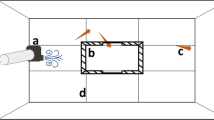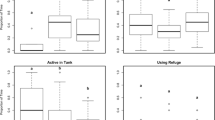Abstract
The influence of hunger level and predation risk on habitat choice and foraging in crucian carp, Carassius carassius, were studied in a laboratory experiment. Experiments were carried out in aquaria with or without a predator (pike, Esox lucius). Habitat use and foraging activity of three-fish foraging groups of either fed or hungry crucian carp were studied. Fish were allowed to choose between an open (risky) habitat with Tubifex worms and a habitat with dense vegetation (safe) without food. Habitat use was significantly affected by both risk of predation and hunger level. Crucian carp spent less time in the open habitat when there was a predator present and they also spent less time there when fed than when hungry. Furthermore, there was a significant interaction between risk of predation and hunger level, indicating a state-dependent trade-off between food acquisition and predator avoidance.
Similar content being viewed by others

References
Andersson KG, Brönmark C, Herrmann J, Malmqvist B, Otto C, Sjöström P (1986) Presence of sculpins (Cottus gobio) reduces drift and activity of Gammarus pulex (Amphipoda). Hydrobiologia 133: 209–215
Cerri RD, Fraser DF (1983) Predation and risk in foraging minnows: balancing conflicting demands. Am Nat 121: 552–561
Dill JM, Fraser AHG (1984) Risk of predation and the feeding behaviour of juvenile coho salmon (Oncorhynchus kisutch). Behav Ecol Sociobiol 16: 65–71
Gilliam JF (1982) Habitat use and competitive bottlenecks in size-structured fish populations. Dissertation, Michigan State University, East Lansing, Michigan, USA
Godin J-GJ, Smith AS (1988) A fitness cost of foraging in the guppy. Nature 333: 69–71
Godin J-GJ, Sproul CD (1988) Risk taking in parasitized sticklebacks under threat of predation: effects of energetic need and food availability. Can J Zool 66: 2360–2367
Gotceitas V (1990) Foraging and predator avoidance: a test of a patch choice model with juvenile bluegill sunfish. Oecologia 83: 346–351
Gotceitas V, Godin J-GJ (1991) Foraging under the risk of predation in juvenile Atlantic salmon (Salmo salar L.): effects of social status and hunger. Behav Ecol Sociobiol 29: 255–261
Holopainen IJ, Tonn WM, Paszkowski CA, Pitkänen AK (1988) Habitat use, diel activity, and growth of crucian carp in a manipulated pond. Verh Int Ver Limnol 23: 1743–1750
Holopainen IJ, Tonn WM, Paszkowski CA (1991) Ecological responses of crucian carp populations to predation by perch in a manipulated pond. Verh Int Ver Limnol 24: 2412–2417
Ivlev VS (1961) Experimental ecology of the feeding of fishes. Yale University Press, New Haven
Kerfoot WC, Sih A (eds) (1987) Predation: Direct and indirect impacts on aquatic communities. University Press of New England, Hanover London
Lima SL, Dill LM (1990) Behavioral decisions made under the risk of predation: a review and prospectus. Can J Zool 68: 619–640
Magnhagen C (1988a) Predation risk and foraging in juvenile Pink (Oncorhynchus gorbuscha) and Chum salmon (O. keta). Can J Fish Aquat Sci 45: 592–596
Magnhagen C (1988b) Changes in foraging as a response to predation risk in two gobiid fish species, Pomatoschistus minutus and Gobius niger. Mar Ecol Prog Ser 49: 21–26
Mangel M (1990) A dynamic habitat selection game. Math Biosci 100: 241–248
Mangel M, Clark CW (1986) Towards a unified foraging theory. Ecology 67: 1127–1138
Mangel M, Clark CW (1988) Dynamic modeling in behavioural ecology. Princeton University Press, Princeton, New Jersey
McFarland DJ, Sibly RM (1975) The behavioural final common path. Philos Trans R Soc London Ser B 270: 265–293
McNamara JM, Houston AI (1986) The common currency for behavioral decisions. Am Nat 127: 358–378
McNamara JM, Houston AI (1987) Starvation and predation as factors limiting population size. Ecology 68: 1515–1519
McNamara JM, Houston AI (1990) Starvation and predation in a patchy environment. In: Shorrocks B, Swingland IR (eds) Living in a patchy environment. Oxford University Press, Oxford, pp 23–43
McNamara JM, Houston AI, Krebs JR (1990) Why hoard? The economics of food storing in tits. Behav Ecol 1: 12–23
Milinski M, Heller R (1978) Influence of a predator on the optimal foraging behaviour of sticklebacks (Gasterosteus aculeatus J.). Nature 275: 642–644
Mittelbach G (1984) Predation and resource partitioning in two sunfishes (Centrarchidae). Ecology 65: 499–513
Mittelbach G (1986) Predator-mediated habitat use: some consequences for species interactions. Environ Biol Fish 16: 159–169
Moreno J, Carlson A, Alatado RV (1988) Winter energetics of coniferous forest tits Paridae in the north: the implications of body size. Funct Ecol 2: 163–170
Nikolskij GV (1963) The ecology of fishes. Academic Press, London
Petranka JW, Fakhoury K (1991) Evidence of a chemically-mediated avoidance response of ovipositing insects to bluegills and green frog tadpoles. Copeia 1: 234–239
Petranka JW, Kats LB, Sih A (1987) Predator-prey interactions among fish and larval amphibians: use of chemical cues to detect predatory fish. Anim Behav 35: 420–425
Pfeiffer W (1962) The fright reaction of fish. Biol Rev 37: 495–511
Piironen J, Holopainen IJ (1986) A note on the seasonality in anoxia tolerance of crucian carp (Carassius carassius (L.)) in the laboratory. Ann Zool Fenn 23: 335–338
Piironen J, Holopainen IJ (1988) Length structure and reproductive potential of crucian carp (Carassius carassius (L.)) populations in some small forest ponds. Ann Zool Fenn 25: 203–208
Power ME (1984) Depth distributions of armoured catfish: predator-induced resource avoidance? Ecology 65: 523–528
Power ME, Matthews WJ (1983) Algae-grazing minnows (Campostoma anomalum) piscivorous bass (Micropterus spp.), and the distribution of attached algae in a small prarie-margin stream. Oecologia 60: 328–332
Power ME, Matthews WJ, Stewart AJ (1985) Grazing minnows, piscivorous bass, and stream algae: dynamics of a strong interaction. Ecology 66: 1448–1456
Pyke GH (1984) Optimal foraging theory: a critical review. Annu Rev Ecol Syst 15: 523–575
Rahel FJ, Stein RA (1988) Complex predator-prey interactions and predator intimidation among crayfish, piscivorous fish, and small benthic fish. Oecologia 75: 94–98
Savino JF, Stein RA (1989) Behavioural interactions between fish predators and their prey: effects of plant density. Anim Behav 37: 311–321
Sih A (1987) Predators and prey lifestyles: an evolutionary and ecological overview. In: Kerfoot WC, Sih A (eds) Predation: direct and indirect impacts on aquatic communities. University Press of New England. Hanover London, pp 203–224
Smith RJF (1992) Alarm signals in fish. Rev Fish Biol Fish 2: 33–63
Stein RA (1979) Behavioral response of prey to fish predators. In: Stroud RH, Clepper H (eds) Predator-prey systems in fisheries management. Sport Fishing Institute, Washington, pp 343–353
Stephens DW, Krebs JR (1986) Foraging theory. Princeton University Press, Princeton, New Jersey
Tonn WM, Paszkowski CA, Holopainen IJ (1989) Responses of crucian carp populations to differential predation pressure in a manipulated pond. Can J Zool 67: 2841–2849
Tonn WM, Paszkowski CA, Holopainen IJ (1992) Piscivory and recruitment: mechanisms structuring prey populations in small lakes. Ecology 73: 951–958
Werner EE, Gilliam JF, Hall DJ, Mittelbach GG (1983) An experimental test of the effects of predation risk on habitat use in fish. Ecology 64: 1540–1548
Author information
Authors and Affiliations
Rights and permissions
About this article
Cite this article
Pettersson, L.B., Brönmark, C. Trading off safety against food: state dependent habitat choice and foraging in crucian carp. Oecologia 95, 353–357 (1993). https://doi.org/10.1007/BF00320988
Received:
Accepted:
Issue Date:
DOI: https://doi.org/10.1007/BF00320988



